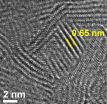NEIKER fells pine trees to study their wind resistance
2014-11-04
(Press-News.org) Forestry experts of the French Institute for Agricultural Research INRA together with technicians from NEIKER-Tecnalia and the Chartered Provincial Council of Bizkaia felled radiata pine specimens of different ages in order to find out their resistance to gales and observe the force the wind needs to exert to blow down these trees in the particular conditions of the Basque Country.
This experience is of great interest for the managers of forests and will help them to manage their woodlands better and incorporate the wind variable into decisions like the distribution of plantations, or the most propitious moment for felling the trees.
Professionals like timber growers in the forestry sector, foresters, forestry technicians and researchers gathered to witness the simulation from close quarters. The trees were felled with steel cables that act as the wind force and which were fitted with sensors to measure the force need to bring the trees down. Each radiata pine had been fitted with three tilt meters that recorded the degree of tilt according to the force exerted on the tree. That way it was possible to determine the resistance of the roots and the strength of the trunk, two essential parameters to find out the capacity of the tree to withstand the thrust of the wind.
The experience carried out this morning is part of the seminar 'FORRISK: Wind damage risk in forests', which took place in the Bizkaia Aretoa in Bilbao, and was organised by NEIKER-Tecnalia in collaboration with the Chartered Provincial Council of Bizkaia, HAZI and the Atlantic Regional Office of EFI (European Forest Institute). The seminar is part of the European project "FORRISK- Network for innovation in silviculture and integrated systems for forest risk management". This initiative has been co-funded by the ERDF and by the Sub-Ministry for Agriculture, Fisheries and Food Policy of the Government of the Basque Autonomous Community (region). The seminar took place in Bilbao because of its status as European Forest City 2014.
The seminar was used to present the detailed map of the characteristics of the wind in the Basque Country, which timber growers and forestry managers can now avail themselves of.The map has been produced by researchers at INRA, the French Institute for Agricultural Research, who have used information from the 57 meteorological stations equipped with anemometers in the network of the Basque Meteorological Authority, Euskalmet.
A tool for estimating wind damage
Those attending the seminar also had the chance to get to know the ForestGALES computing tool that allows managers to estimate the probability of wind damage in forests. ForestGALES was originally created for Britain and has been adapted to the characteristics of the Basque geography by INRA, NEIKER-Tecnalia and HAZI technicians. This innovative application is of great use in specifying concrete actions (for example: spacing, silvicultural interventions like clearing or thinning) bearing in mind the probability of wind damage on each plot.
To get the most out of this tool, it is necessary to know the resistance of the roots and strength of the trunks of the relevant species, as well as the characteristics of the wind where the trees are growing.So today's simulation and the Basque wind map are two fundamental components for developing the ForestGALES model.
Increase in extreme winds owing to climate change
Cyclones like Klaus (2009) and Xynthia (2010) brought down over 200,000 cubic metres of timber as they passed through the Basque Country, owing to gusts of winds in excess of 228 kilometres per hour. Predictions indicate that the frequency of extreme phenomena like these is set to increase owing to climate change. So the forestry sector needs to have information and tools that will enable it to tackle the risks resulting from the wind.
INFORMATION:
ELSE PRESS RELEASES FROM THIS DATE:
2014-11-04
A University of Tennessee, Knoxville, study finds that nonprofit organizations aiming to protect biodiversity show little evidence of responding to economic signals, which could limit the effectiveness of future conservation efforts.
The study is published this week in the academic journal Ecology and Evolution and can be read at http://bit.ly/1t8fT24.
The relationship between economic conditions and conservation efforts is complicated. On the one hand, funding for conservation depends on a booming economy, which swells state coffers and increases membership dues, ...
2014-11-04
Only forty per cent of the notable increase in autism cases that has been registered during the past few decades is due to causes that are as yet unknown.
The majority of the increase – a total of sixty per cent – can now be explained by two combined factors: changes in the diagnostic criteria and in the registration to the national health registers.
This is shown by a new study of disease prevalence among all individuals born in Denmark in the period 1980-1991, a total of 677,915 individuals.
The results have recently been published in the medical journal ...
2014-11-04
If you can uniformly break the symmetry of nanorod pairs in a colloidal solution, you're a step ahead of the game toward achieving new and exciting metamaterial properties. But traditional thermodynamic -driven colloidal assembly of these metamaterials, which are materials defined by their non-naturally-occurring properties, often result in structures with high degree of symmetries in the bulk material. In this case, the energy requirement does not allow the structure to break its symmetry.
In a study led by Xiang Zhang, director of Berkeley Lab's Materials Sciences ...
2014-11-04
Researchers at the University of Cambridge have managed to reconstruct the early stage of mammalian development using embryonic stem cells, showing that a critical mass of cells – not too few, but not too many – is needed for the cells to being self-organising into the correct structure for an embryo to form.
All organisms develop from embryos: a cell divides generating many cells. In the early stages of this process, all cells look alike and tend to aggregate into a featureless structure, more often than not a ball. Then, the cells begin to 'specialise' into ...
2014-11-04
Los Angeles, CA (November 4, 2014) How does an individual's happiness level reflect societal conditions? A new article out today in the first issue of Policy Insights from the Behavioral and Brain Sciences (PIBBS) finds that similar to how GDP measures the effectiveness of economic policies, happiness can and should be used to evaluate the effectiveness of social policies.
Authors Shigehiro Oishi and Ed Diener examined research evaluating the effectiveness of policy related to unemployment rate, tax rate, child care, and environmental issues to determine if it's possible ...
2014-11-04
Los Angeles, CA (November 4, 2014) The growing disparity in economic inequality has become so stark that even Janet Yellen, Federal Reserve chairwoman, recently expressed concern. Interestingly, new research has discovered that American citizens desire an unequal, but more equal distribution of wealth and income. Lower levels of this "unequality" are associated with decreased unethical behavior and increased motivation and labor productivity. This study is published today in the inaugural issue of Policy Insights from the Behavioral and Brain Sciences (PIBBS).
"People ...
2014-11-04
Los Angeles, CA (November 4, 2014) With so much attention to curriculum and teaching skills to improve student achievement, it may come as a surprise that something as simple as how a classroom looks could actually make a difference in how students learn. A new analysis finds that the design and aesthetics of school buildings and classrooms has surprising power to impact student learning and success. The paper is published today in the inaugural issue of Policy Insights from the Behavioral and Brain Sciences (PIBBS).
Surveying the latest scientific research, Sapna Cheryan, ...
2014-11-04
SALT LAKE CITY, Nov. 4, 2014 – University of Utah engineers have developed a new type of carbon nanotube material for handheld sensors that will be quicker and better at sniffing out explosives, deadly gases and illegal drugs.
A carbon nanotube is a cylindrical material that is a hexagonal or six-sided array of carbon atoms rolled up into a tube. Carbon nanotubes are known for their strength and high electrical conductivity and are used in products from baseball bats and other sports equipment to lithium-ion batteries and touchscreen computer displays.
Vaporsens, ...
2014-11-04
PROVIDENCE, R.I. [Brown University] — We celebrate our triumphs over adversity, but let's face it: We'd rather not experience difficulty at all. A new study ties that behavioral inclination to learning: When researchers added a bit of conflict to make a learning task more difficult, that additional conflict biased learning by reducing the influence of reward and increasing the influence of aversion to punishment.
This newly found relationship between conflict and reinforcement learning suggests that the circuits in the frontal cortex that calculate the degree of ...
2014-11-04
HOUSTON – (Nov. 4, 2014) – Rice University scientists who want to gain an edge in energy production and storage report they have found it in molybdenum disulfide.
The Rice lab of chemist James Tour has turned molybdenum disulfide's two-dimensional form into a nanoporous film that can catalyze the production of hydrogen or be used for energy storage.
The versatile chemical compound classified as a dichalcogenide is inert along its flat sides, but previous studies determined the material's edges are highly efficient catalysts for hydrogen evolution reaction ...
LAST 30 PRESS RELEASES:
[Press-News.org] NEIKER fells pine trees to study their wind resistance


